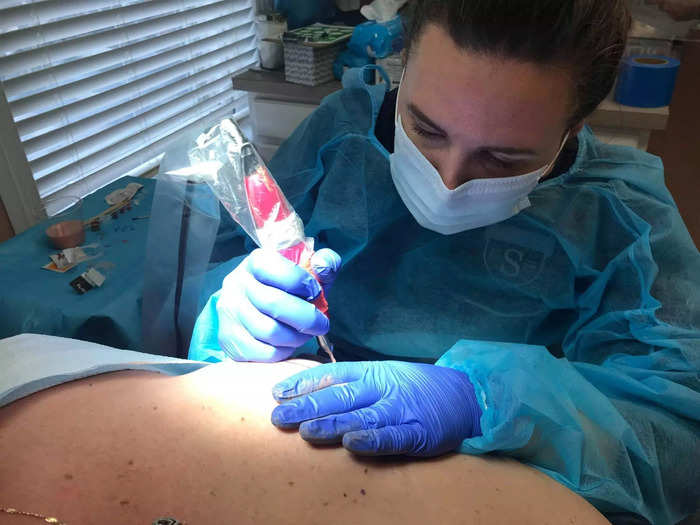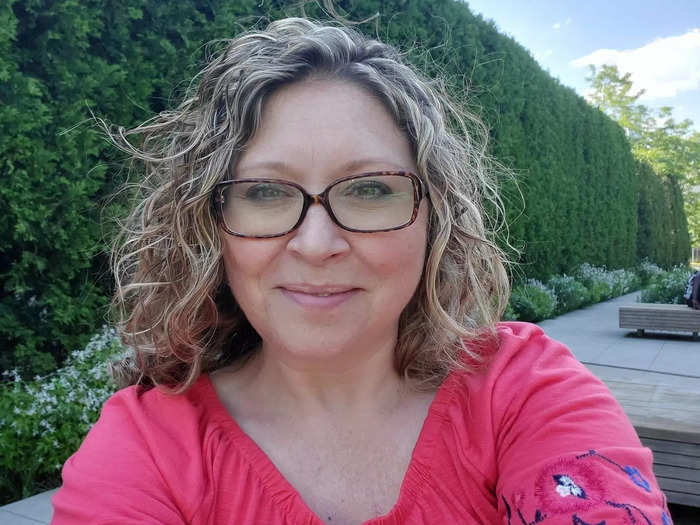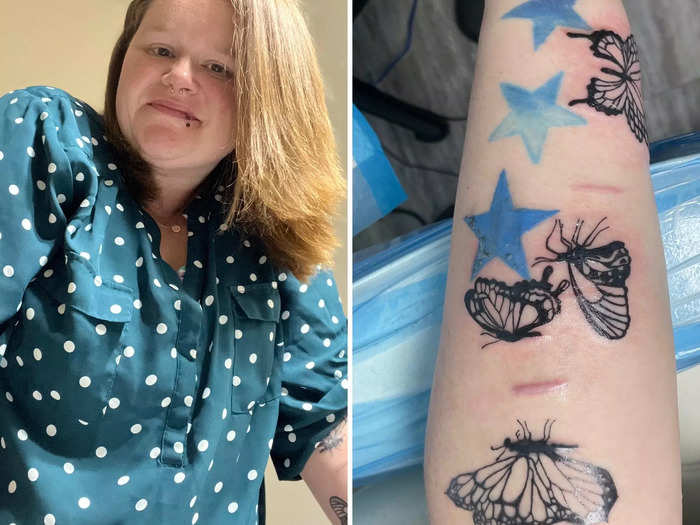Samantha Warmbrodt covered self-harm scars with medical tattoos.Jenean LaCorte
- Medical tattoos, designed to replicate nipples and camouflage scars, have become popular.
- A medical-tattoo artist and two clients say the tattoos have physical and emotional benefits.
Medical tattoos have become popular in recent years.
Researchers at the University of Central Florida said in a paper published in the journal Aesthetic Surgery Journal Open Forum in 2021 that the technique was "increasingly used with many medical conditions," adding that it could help camouflage scars, burns, and vitiligo.
People who've had breast cancer can get the tattoos to simulate the appearance of nipples after a mastectomy. A 2020 paper by researchers at Georgetown University Medical Center suggested that "tattoos are safer than nipple reconstruction with grafts."
Jenean LaCorte, 45, a classically trained artist who works as a medical tattooist, founded her one-woman business in 2018. She switched from watercolor painting to the tattoo business after a relative who'd had cancer got nipples tattooed on her breasts following surgery.
"She was disappointed with the results, and I thought, 'People deserve better'" LaCorte told Insider.
She specializes in 3D effects that can imitate the look of areolae. "I use delicate shading techniques," LaCorte said.
She said the procedure — which costs about $600 — is offered at a discount to some breast-cancer survivors who can't afford it, as well as to some people with self-harm scars.
"We get a lot of donations," LaCorte said. The fund for her clients' tattoos is also supported by Desert Harvest, a company that makes an aloe-vera cream for tattooed skin.
These as-told-to essays are based on conversations with LaCorte, Kara Kenan, and Samantha Warmbrodt. They have been edited for length and clarity.
LaCorte left her career as a classical artist to become a medical tattooist.
LaCorte. Jenean LaCorte
Medical tattoos are frequently done by doctors and nurses or regular tattooists. They're often just a solid circle of color and not placed in the right spot. There can be no artwork or skill set involved.
Most breast-cancer survivors have undergone radiation or chemotherapy. It needs to be treated differently. Radiation destroys the fibers of the skin. It makes it very fragile, like crepe paper that can easily tear or shred. You have to adjust the depth of the needle and how fast the pen moves. Otherwise you can create a lot of scar damage.
About 80% of my procedures are for nipples The rest camouflages surgical scars (including cesareans), birthmarks, and scars or burns caused by an accident. One woman is getting a toenail because she lost it due to diabetes.
I do the shading with inks that some people might think are the same color. But the pigments have very subtle differences to exactly match skin tones and in some cases, like nipples, create a 3D effect.
Women who want nipples tend to prefer a female tattoo artist. I try to make them feel at ease. They tell me about their treatment. When I see them at the follow-up, they say how much the tattoos have changed them — even if it's just to get in the shower in the morning and not think, "I've had cancer."
Kara Kenan, 44, had reconstruction after her treatment for breast cancer, and she went on to get nipple tattoos.
Kenan. Kara Kenan
I was diagnosed with breast cancer at the age of 35. The treatment lasted from the end of 2013 to the end of 2014. I had a bilateral mastectomy. Then it was six months of chemotherapy and a month's radiation. I had my breast reconstruction in December 2014.
But part of the treatment was having my estrogen suppressed, particularly because I also needed a hysterectomy. I gained a lot of weight because of steroids. It got to the point when I couldn't look at my body in the mirror. My body went through so much. I didn't have nipples. I thought, "What else of my femininity can they take away from me?"
But I knew that I wasn't alone in my feelings. I founded the nonprofit organization Going Beyond the Pink in 2017. We give face-to-face advice to cancer patients in our home state of North Carolina. We support other people online, including caregivers.
I knew LaCorte through my breast-cancer work. I'd seen some of the results of her work in our community. So in 2020, I got my nipples tattooed. It was the first time I'd had a tattoo, and I was a little nervous. But there was no need. She put some Lidocaine cream on my skin, and it was mostly painless.
My husband, Doug, hesitated to look at them right off the bat. His idea of getting a tattoo was that things would look gross at the start — he wanted to wait until it was more or less healed. But when I got home, I looked at my nipples in the mirror and pranced around the bathroom. They were so realistic.
Then a day or two later, I went ahead and showed Doug. He was amazed. He ran his finger over the top of them to check whether or not the surface was flat. LaCorte understands dimension and shading. She knows how to play a trick on the eye.
I don't even notice them now. They're a regular part of me. After cancer, I felt ashamed and wanted to hide my body. It was a new trauma every time I looked at myself. Now I feel comfortable and whole again.
Samatha Warmbrodt, 34, got medical tattoos to cover scars on her arm caused by self-harm.
Warmbrodt. Samantha Warmbrodt
The year 2021 was a difficult one for me. I went through the breakup of my marriage and became a single mom of five. I started cutting in November 2021. Luckily, I was able to get therapy and stopped.
I wasn't ashamed of my scars. But when people saw my arm, I felt as if they were assuming the worst. I thought that they were judging me.
I'd wear long sleeves that covered up my arms, even in summer. I hated it. I tried different creams that were supposed to lessen the scars.
I knew that tattoos were used to disguise scars. But when I reached out to tattoo artists in the area, they didn't want to help. They said they were uncomfortable with the scarring. One person said that the ink doesn't always work on damaged skin. Another said that I needed to wait until the scars had faded in six to 10 years' time.
But I couldn't wait that long. A friend recommended Jenean. We decided on the butterfly theme because it represented change and renewal. She used my raised scars as the center of each butterfly. They look 3D.
I already have a lot of tattoos, but the butterflies are my favorite. In January, LaCorte is going to put two bumblebees over the two scars that are left. I paid $300, but the rest was covered by anonymous donations.
These days I don't have to wear long sleeves. I work at a nursery school, and the kids sometimes look at my arm — they say that they love the butterflies.
My tattoos have become part of my healing journey.
Do you have a powerful story to share with Insider? Please send details to jridley@insider.com.



